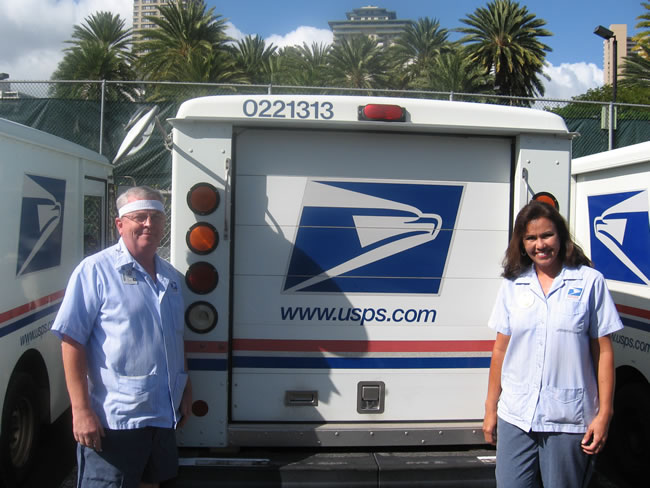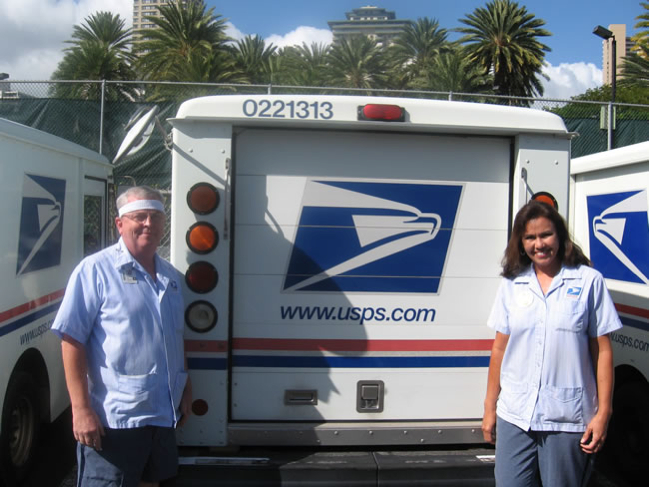Letter Carriers Deliver For The Hungry
USPS mail carriers are calling for the community to help Stamp Out Hunger. This year’s food drive marks the 20th anniversary of the national program
You see them every day walking and driving through your neighborhoods. Some have been around to see your kids and families grow. You may have a friendly relationship with them, stopping each other once in awhile to say hello and talk story.
They’re our neighborhood mail carriers, and they work hard to deliver each precious and sometimes not so precious pieces of mail to our homes. This week these same mail carriers will carry on a tradition that is driven to help our neighbors who are having difficulty feeding themselves and their families.
Bruce McDowell and Adele Yoshikaw
The 20th annual National Association of Letter Carriers’ Food Drive takes place May 12, and the United States Postal Service and all its representatives are asking for help in an effort to “Stamp Out Hunger.” More than 240,000 mail carriers throughout the U.S. will lead this effort and pick up food donations. On Oahu, every pound of food will be given to Hawaii Foodbank and will be distributed to those in need on our island. Each of the Neighbor Islands also has a Stamp Out Hunger drive on the same day. Tallied as the nation’s largest one-day food drive, Stamp Out Hunger collected 70.2 million pounds of food last year alone, and more than 1 billion pounds have been collected during the course of its first 19 years. Across the state of Hawaii, mail carriers were able to collect 490,000 pounds of food items during last year’s drive.
Looking back on the first 19 years is mail carrier Bruce McDowell, who has been coordinating the food drive for its duration on Oahu.
“This drive took awhile. We used to get a lot of bad cans, a lot of rusty cans. It took us about four or five years before we got it down,” says McDowell, who will retire from USPS and move to Florida by the end of the year. What used to take close to three to four months of sorting has been meticulously condensed to a mere day or two. Much of the organizational credit has to be given to McDowell, as well as co-coordinators and fellow mail carriers Adele Yoshikawa and Wade Teraoka.
“We get people who come out to thank us personally. I remember speaking to a guy who just lost his job and I saw the look on his face. I said to my partner, ‘this is why we’re doing it,'” adds McDowell, who recalls spending weeks at a time in a warehouse on Sand Island sorting cans in the early years.
“There were cages and cages of food. You’d walk out of there covered in dirt. We’ve certainly changed over the years. Presorting started in our Wahiawa office. It took a couple of years, but now we’re able to sort the food in almost one night instead of months.”
As the food drive has grown exponentially over the past two decades, the help of volunteers has grown equally, which is an enormous help and shows how dedicated the community can be.
“Through the years we learned how to make things better. I remember I would-n’t go home until 9 or 10 p.m. some evenings from sorting. Now we’ve got volunteers from youth groups, high schools and different organizations, and we’re usually waiting for the last trucks to arrive to finish sorting,” says Yoshikawa, who has been a mail carrier for more than 13 years.
With an economy that has been struggling to pick itself up, the food drive has seen a slight decrease in donations the past few years, but for the carriers it’s a positive feeling to walk up to people’s homes and see cans and donations in the marked blue bags.
“It used to be about beating the previous year’s donations. Now, any donation, even if it’s one extra can, will help put another meal on the table – that’s the goal,” adds Yoshikawa.
On May 12 mail carriers will collect donations in USPS-issued bags that have been sent to residences. They encourage early donations and will accept them the week after for those who may forget to leave their donations on collection day. The most desired items include canned meats or tuna, canned meals, stew or spaghetti, canned soups and canned fruits and vegetables.
Caring is what has made the food drive as successful as it has been, and the same compassion will carry the drive each year possible.
“As long as we are in business, we’ll still be collecting,” says McDowell. “Unfortunately we can’t stamp out hunger for good, but we’re trying.”







